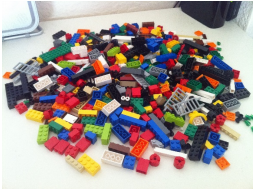2.1.3: Analysis
- Page ID
- 60203
Analysis
On a basic level, analysis refers to the conceptual strategy of "part-to-whole." Because I grew up playing with LEGOs® (or, more often, the cheap knock-offs), I like to use this analogy: Imagine a castle built of 1000 LEGO bricks. I can look at the entire structure and say, "Oh, that's a castle"- this is a reasonable interpretation. But to understand how that e has actually come together, I pull a few of the LEGO bricks from various parts of the structure. I look at those bricks individually, closely examining each side ( even the side that I couldn't see when they were part of the castle).

"lego pile" by justgrimes is licensed under CC BY-SA 2.0

":jovian:" by bf8done is licensed under CC BY-NC 2.0
When I say "This is a castle," I am not analyzing . But next, perhaps I ask myself, "What is each of these blocks doing to create what I can clearly interpret as a castle?" This is the process of analysis.
Which bricks to choose, though? As we discussed in Chapter One, attention is always selective: we automate most of our daily experience for the sake of efficienct and survival, so we often overlook the trees when we see the forest -or each LEGO brick when we see the castle.
Analysis, then, is a practice of radical noticing (like description): it invites you to attend to the details that add up to a complex reality. But analysis also involves conscientious focus of your attention, or a lens. Just like reading glasses can bring these words into focus, an analytical lens brings specific ideas, words, or patterns into sharper focus, making them easier to process and interpret.
Sometimes, especially in English classrooms, analysis of a text is referred to as close reading.2 Importantly, close reading as a technique is not a magical key to meaning, not a super-secret decoder ring for a deeply encrypted code. Rather, it is a means to unpack a text and construct a unique, focused interpretation. Close reading is an iterative process: by repeatedly encountering, unpacking, and discussing a text, you can develop an analytical insight thought guided and focused interpretations of its meaning.
In an analytical situation, your readerly purpose might determine your focus: for example, if you're trying to convince a friend that Wonder Woman is a feminist film, you would keep your eyes peeled for images, words, and other makers that align with such an interpretation, like situations featuring independent powerful women or an equitable ratio of dialogue spoken by female characters vs. male characters. It is important to note, though, that good analysis embraces curiosity and allows you to notice elements that might contradict, complicate, or nuance your original purpose: in addition to finding evidence in support of your interpretation, you should also be aware of characteristics that push back against your expectations.
Chapter Vocabulary
| Vocabulary | Definition |
| authorial intent | the inferred or speculated intention of a writer. Must be overlooked in the process of text wrestling analysis. |
| analysis | the cognitive process and/or rhetorical mode of studying constituent parts to demonstrate an interpretation of a larger whole. |
| connotation | the associated meanings of a word, phrase, or idea beyond its 'dictionary' definition; the complex, subjective, and dynamic meanings of a word, phrase, or idea the shift based on interpretive position, Contrast with denotation. |
| close reading | a technique of reading that focuses attention on features of the text to construct an interpretation. (This is in contrast to interpretive methods that rely on research, historical context, biography, or speculation.) |
| denotation | the dictionary definition of a word, phrase, or idea; the standard and objective meaning of a word, phrase, or idea which, theoretically, does not vary based on interpretive position. Contrast with connotation. |
| interpretation | the process of consuming rhetoric to create meaning. "An interpretation" refers to a specific meaning we build as we encounter a text, focusing on certain ideas, language, or patterns. |
| interpretive position | the unique position from which each of us interprets a text-necessarily different for all people at any given time, and often different for the same person at different times in their life. |
| iterative | literally, a repetition within a process. Analysis is iterative because it requires repeated critical encounters with a text. |
| lens | a metaphor for the conceptual framework a reader applies to an analysis. A "lens" brings certain elements into focus, allowing the reader to attend to specific parts of a text to develop an interpretation. |
| motif | a recurring image or phrase that helps convey a theme. Similar to a symbol, but the relationship between symbol and symbolized is more one-to-one than between motif and theme. |
| pattern | a notable sequence; structure or shape; recurring image, word, or phrase found in a piece of rhetoric. |
| reference | a connection a text makes to another text. Can be explicit or implicit; might include allusion, allegory, quotation, or parody. Referencing text adopts some characteristics of the referenced text. |
| symbol | an artifact (usually something concrete) that stands in for (represents) something else (often something abstract). |


